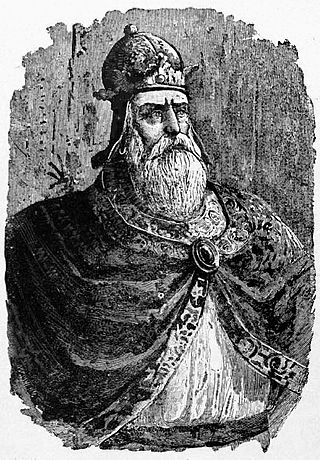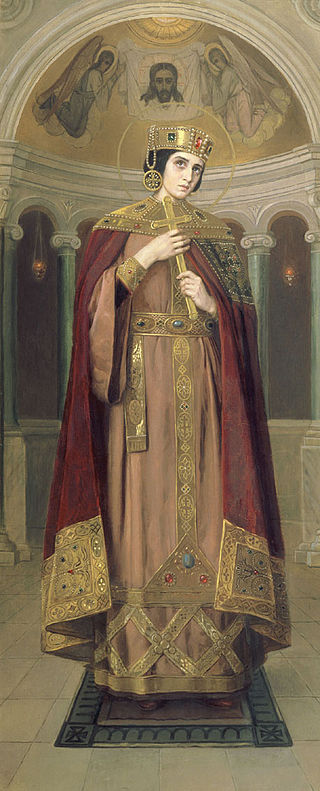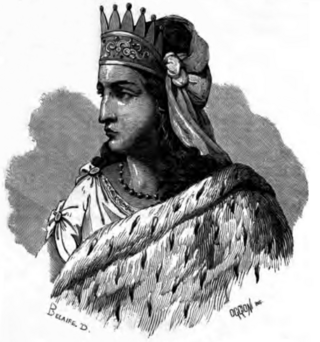Biography
According to legend, Hripsime was possibly of noble birth. [4] She belonged to a community of virgins in Rome, numbering 35 [5] under the leadership of Gayane. She was known to be extremely beautiful and attracted the notice of Diocletian. To avoid his advances she, along with her community, fled the city, going first to Alexandria before settling in Vagharshapat. [3] The varying accounts of her martyrdom diverge at this point. One story indicates that Hripsime again was noticed for her beauty, this time by King Tiridates III, who proceeded to pursue her. Upon being brought before him, she refused his advances and was punished by being roasted alive. Gayane was then put to death by Tiridates' soldiers, as were all the members of her community except for Nune (or Marine), who was later a missionary in Georgia [3] and, as Saint Nino, is praised as the founder of the Georgian Orthodox Church.
Another version of the Saint's Acts indicates that, upon discovering Hripsime's whereabouts, Diocletian sent a letter to Tiridates insisting that he either send her back or take her for himself. The king's servants found her among her companions, the nuns, and urged her to follow his wishes. She responded that she could not marry as she was betrothed to Jesus Christ, as were the others. At this, a voice from heaven was heard, saying, "Be brave and fear not, for I am with you". [6] Upon this, Tiridates ordered that Hripsime be tortured; her tongue was cut out, her stomach cut open, and she was blinded before being killed. Her body was then cut into pieces. Inspired by her example, Gayane and two other nuns gave themselves over to similar treatment before being beheaded. The rest of the community was put to the sword, their bodies thrown to the beasts to be eaten. By God's Will, Tiridates and his soldiers were punished by God for their actions; the soldiers were beset by devils and began acting like wild animals, running through the forests, gnawing at themselves, and tearing their clothes. [6] The King was then turned into a wild boar for his actions, and had to be saved by the intervention of Gregory the Illuminator. [7]

Gregory the Illuminator was the founder and first official head of the Armenian Apostolic Church. He converted Armenia from Zoroastrianism to Christianity in the early fourth century, making Armenia the first state to adopt Christianity as its official religion. He is venerated as a saint in the Armenian Apostolic Church and in some other churches.

Agnes of Rome is a virgin martyr, venerated as a saint in the Catholic Church, Oriental Orthodox Church and the Eastern Orthodox Church, as well as the Anglican Communion and Lutheran Churches. She is one of several virgin martyrs commemorated by name in the Canon of the Mass, and one of many Christians martyred during the reign of the Roman emperor Diocletian.

Year 303 (CCCIII) was a common year starting on Friday of the Julian calendar. It was known in the Roman Empire as the Year of the Consulship of Diocletian and Maximian. The denomination 303 for this year has been used since the early medieval period, when the Anno Domini calendar era became the prevalent method in Europe for naming years.

Bartholomew was one of the twelve apostles of Jesus according to the New Testament. Most scholars today identify Bartholomew as Nathanael, who appears in the Gospel of John.

Saint Nino was a woman who preached Christianity in the territory of the Kingdom of Iberia, in what is modern-day Georgia. Her preaching resulted in the Christianization of Iberia.

Tiridates III, also known as Tiridates the Great or Tiridates IV, was the Armenian Arsacid king from c. 298 to c. 330. In the early 4th century, Tiridates proclaimed Christianity as the state religion of Armenia, making the Armenian kingdom the first state to officially embrace Christianity.

Saint Anastasia is a Christian saint and martyr who died at Sirmium in the Roman province of Pannonia Secunda. In the Eastern Orthodox Church, she is venerated as St. Anastasia the Pharmakolytria, i.e. "Deliverer from Potions". This epithet is also translated as "One who Cures (Wounds)" in Lampe's A Patristic Greek Lexicon.

Alexandra of Rome was a Christian martyr and saint, known from Martyrdom of Saint George as either Emperor Diocletian's wife or the wife of Dacian, a Roman Prefect. She is also sometimes mistaken with Priscilla or Prisca.

Eulalia, co-patron saint of Barcelona, was a 13-year-old Roman Christian virgin who was martyred in Barcelona during the persecution of Christians in the reign of emperor Diocletian. There is some dispute as to whether she is the same person as Eulalia of Mérida, whose story is similar.

Saints Cyrus and John are venerated as martyrs. They are especially venerated by the Coptic Church and surnamed Wonderworking Unmercenaries because they healed the sick free of charge.

The Saint Gayane Church is a 7th-century Armenian church in Vagharshapat (Etchmiadzin), the religious center of Armenia. It is located within walking distance from the Etchmiadzin Cathedral of 301. St. Gayane was built by Catholicos Ezra I in the year 630. Its design has remained unchanged despite partial renovations of the dome and some ceilings in 1652.

The 20,000 Martyrs of Nicomedia refers to victims of persecution of Christians in Nicomedia, Bithynia by the Roman emperors Diocletian and Maximian in the early 4th century AD.

The Church of Shoghakat was erected in 1694 by Prince Aghamal Sorotetsi during the reign of Catholicos Nahabed I in the city of Vagharshapat (Etchmiadzin), in Armenia's Armavir Province.

Aghjots Vank ; also known as the Saint Stephen Monastery of Goght, is a 13th-century monastery situated along a tributary of the Azat River Valley within the Khosrov State Reserve located half a mile walk from the hamlet of Mets Gilanlar, and near the villages of Goght and Garni in the Ararat Province of Armenia. Not far from this location and also within the reserve is the fortress of Kakavaberd and the monastic complex of Havuts Tar.

Saint Demiana and the 40 virgins was a Coptic martyr of the early fourth century.

Khor Virap is an Armenian monastery located in the Ararat Plain in Armenia, near the border with Turkey, about 8 kilometres (5.0 mi) south of Artashat, Ararat Province, within the territory of ancient Artaxata. The monastery was host to a theological seminary and was the residence of the Armenian Catholicos.

Khosrovidukht also transliterated Xosroviduxt was a princess of the Arsacid dynasty of Armenia, one of the client-kingdoms of the Roman Empire and a branch of the Arsacid dynasty of Parthia.

Ashkhen was the Queen of Armenia and a member of the Arsacid dynasty by marriage to King Tiridates III of Armenia.

December 9 - Eastern Orthodox liturgical calendar - December 11
This page is based on this
Wikipedia article Text is available under the
CC BY-SA 4.0 license; additional terms may apply.
Images, videos and audio are available under their respective licenses.




















